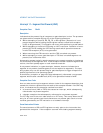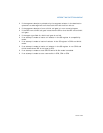
Vol. 3 6-47
INTERRUPT AND EXCEPTION HANDLING
tors for the segment selectors in a new TSS, the CS and EIP registers point to the first
instruction in the new task. If the exception occurred while accessing a gate
descriptor, the CS and EIP registers point to the instruction that invoked the access
(for example a CALL instruction that references a call gate).
Program State Change
If the segment-not-present exception occurs as the result of loading a register (CS,
DS, SS, ES, FS, GS, or LDTR), a program-state change does accompany the excep-
tion because the register is not loaded. Recovery from this exception is possible by
simply loading the missing segment into memory and setting the present flag in the
segment descriptor.
If the segment-not-present exception occurs while accessing a gate descriptor, a
program-state change does not accompany the exception. Recovery from this excep-
tion is possible merely by setting the present flag in the gate descriptor.
If a segment-not-present exception occurs during a task switch, it can occur before
or after the commit-to-new-task point (see
Section 7.3, “Task Switching”). If it
occurs before the commit point, no program state change occurs. If it occurs after
the commit point, the processor will load all the state information from the new TSS
(without performing any additional limit, present, or type checks) before it generates
the exception. The segment-not-present exception handler should not rely on being
able to use the segment selectors found in the CS, SS, DS, ES, FS, and GS registers
without causing another exception. (See the Program State Change description for
“Interrupt 10—Invalid TSS Exception (#TS)” in this chapter for additional information
on how to handle this situation.)


















